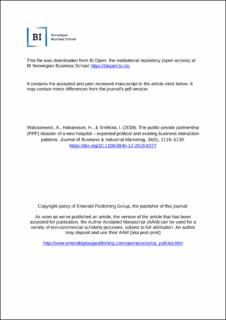The public-private partnership (PPP) disaster of a new hospital ? expected political and existing business interaction patterns
Journal article, Peer reviewed
Accepted version
Permanent lenke
https://hdl.handle.net/11250/2759512Utgivelsesdato
2019Metadata
Vis full innførselSamlinger
- Scientific articles [2217]
Originalversjon
The journal of business & industrial marketing. 2019, 34 (5), 1119-1130. 10.1108/JBIM-12-2018-0377Sammendrag
Purpose
One of the most salient contemporary societal trends is the increasing amount of public–private collaborations. In spite of the increasing awareness of the need to scrutinise the promises of public–private partnership (PPP), there is an important but seldom-asked question: How does the assumed interaction pattern behind PPP correspond with the interaction pattern appearing in empirical studies of the content of business exchange? The purpose of this paper is to shed light on the discrepancy between the expected and actual pattern of interactions in PPPs.
Design/methodology/approach
The paper presents a specific PPP concerning the construction of a Nya Karolinska (NKS) hospital building, which ended up as an economic and functional disaster. With an interactive approach as point of departure (Håkansson et al. 2009; Waluszewski, Håkansson, Snehota, 2017), this paper investigates a) the interaction pattern of the business landscape expected by policy/politicians in the NKS construction case and b) how the assumed interaction pattern appears in relation to the interaction pattern of the business landscape outlined in empirical studies of exchange, in the business landscape in general and of the construction setting in particular.
Findings
Given that the public side is neglecting the interactivity and interdependency of the private business setting, the disappointment with the NKS PPP project does not appear as an odd deviation. Rather, as a natural consequence of a public side expecting autonomous actors able to deliver innovation, quality and cost control just because they are exposed to competitive forces – but in reality interfacing with private actors which interests are directed to interdependent investments in place; own and related suppliers’.
Research limitations/implications
The investigation of the political expectations behind the NKS PPP case was concentrated on two types of data. Original reports expressing the political view of the interaction pattern of the private setting have been used. Four published studies focussing on different aspects of the NKS process, which discuss the political view of the private setting, was also used.
Practical implications
Be it private–private or public–private, to be beneficial for both sides of the exchange interface, both sides have to engage in the exchange – with representatives with knowledge and experiences of all direct and indirect related social and material resources that will be affected. The need to mobilise and involve representatives with extensive experiences of specific resource combinations of both sides of the exchange interface; the public as well as the private, does not disappear simply because it is assumed away.
Social implications
The competitive forces of the private setting are by politicians and policy assumed to function in an automatic way; breeding cost efficiency, quality and innovation. Furthermore, there is also an assumption of speed and ease of change. With the trust in these characteristic sof the private setting at hand, politicians have a “cart blanche” to withdraw from direct involvement in the creation of producer-user interfaces.
Originality/value
The paper underlines that as soon as the public-private exchange concerns goods that cannot be transformed to or treated as homogeneous ‘commodities’, as most often is the case of in this type of processes, there are reasons to be extremely careful in the design of the interaction interface. There are differences both in resource and activity structures between the two sides of the exchange interface and these differences have to be actively dealt with.
